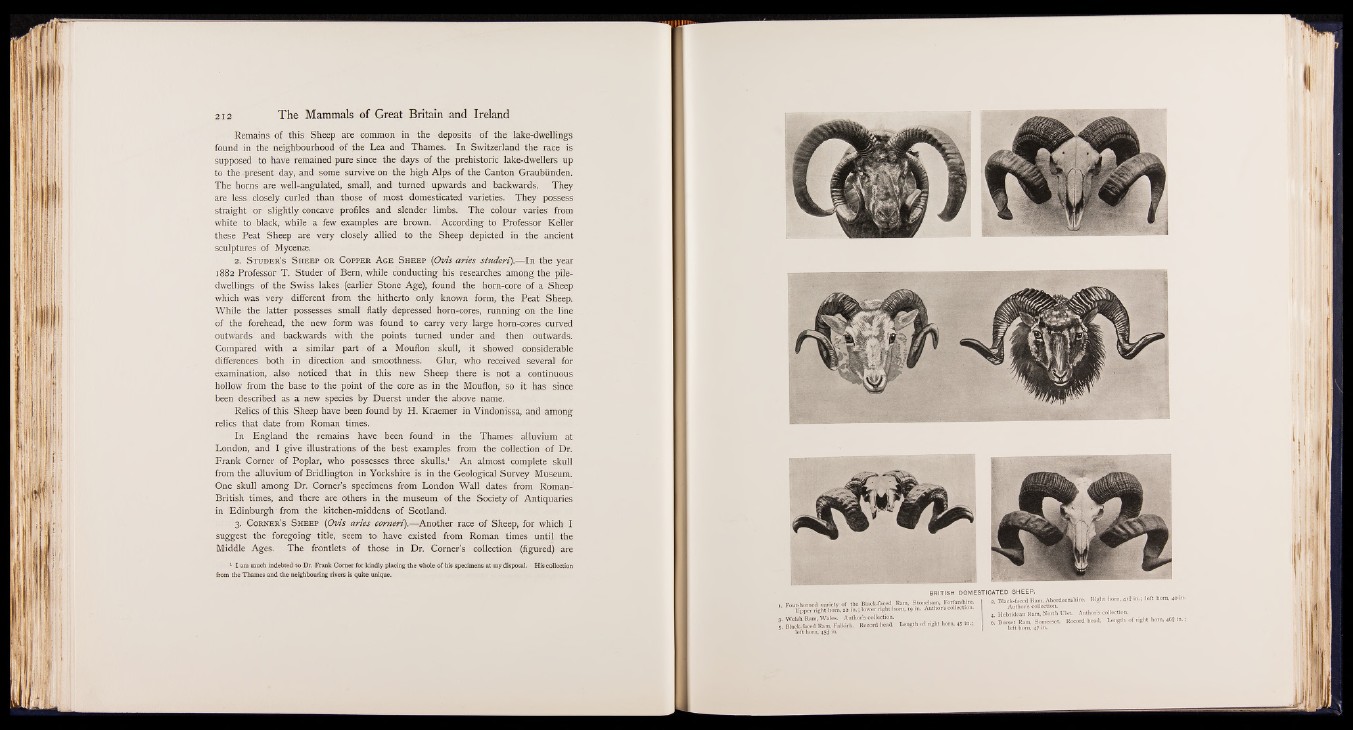
Remains of this Sheep are common in the deposits of the lake-dwellings
found in the neighbourhood of the Lea and Thames. In Switzerland the race is
supposed to have remained pure since the days of the prehistoric lake-dwellers up
to the-present day, and some survive on the high Alps of the Canton GraubUnden.
The horns are well-angulated, small, and turned upwards and backwards. They
are less closely curled than those of most domesticated varieties. They possess
straight or slightly concave profiles and slender limbs. The colour varies from
white to black, while a few examples are brown. According to Professor Keller
these Peat Sheep are very closely allied to the Sheep depicted in the ancient
sculptures of Mycenae.
2. Studer’s S heep or Copper A ge S heep {Ovis aries studeri).— In the year
1882 Professor T. Studer of Bern, while conducting his researches among the pile-
dwellings of the Swiss lakes (earlier Stone Age), found the horn-core of a Sheep
which was very different from the hitherto only known form, the Peat Sheep.
While the latter possesses small flatly depressed horn-cores, running on the line
of the forehead, the new form was found to carry very large horn-cores curved
outwards and backwards with the points turned under and then outwards.
Compared with a similar part of a Mouflon skull, it showed considerable
differences, both in direction and smoothness. Glur, who received several for
examination, also noticed that in this new Sheep there is not a continuous
hollow from the base to the point of the core as in the Mouflon, so it has since
been described as a new species by Duerst under the above name.
Relics of this Sheep have been found by H. Kraemer in Vindonissa, and among
relics that date from Roman times.
In England the remains have been found in the Thames alluvium at
London, and I give illustrations of the best examples from the collection of Dr.
Frank Corner of Poplar, who possesses three skulls.1 An almost complete skull
from the alluvium of Bridlington in Yorkshire is in the Geological Survey Museum.
One skull among Dr. Corner’s specimens from London Wall dates from Roman-
British times, and there are others in the museum of the Society of Antiquaries
in Edinburgh from the kitchen-middens of Scotland.
3; Corner’s S heep {Ovis aries corneri).— Another race of Sheep, for which I
suggest the foregoing title, seem to have existed from Roman times until the
Middle Ages. The frontlets of those in Dr. Corner’s collection (figured) are
1 I am much indebted to Dr. Frank Comer for kindly placing the whole o f his specimens at my disposal. His collection
from the Thames and the neighbouring rivers is quite unique.
1 Four-horned variety of the Black-faced Ram, Stoneham, Forfarshire.
Upper right horn, 22 in.; lower right horn, 19 in. Author s collection.
3. Welsh Ram, Wales. Author’s collection.
| Black-faced Ram, Falkirk. Record head. Length of right horn, 45 in.;
left horn, 45*